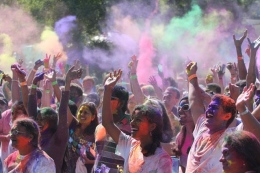New Vrindaban, West Virginia’s only Hare Krishna community and home of the awe-inspiring Palace of Gold, hosted the second annual Festival of Colors Saturday.
The festival, which is modeled after the traditional Indian festival Holi, drew more than 5,000 attendees to the outskirts of Moundsville, W.Va.
The festival blends together elements of a traditional Holi celebration, during which Hindus throw brightly colored perfumed powders into the air in celebration of springtime, with elements of a Western music festival.
Although traditional color festivals are deeply rooted in religious tradition, the event Saturday was a secular celebration of the ideas of The International Society Krishna Consciousness. The event was open to participants of all ages, races, beliefs and walks of life.
Vrindavana Das, project manager for the festival, said the event was meant to be a symbolic celebration of life, unity and peace.
“We are all here today to live our lives and be with one another,” he said. “This is meant to be fun and joyful and to bring us closer to those who are around us.”
Throughout the course of the afternoon, four Krishna-centric bands played; each leading the crowd through their own unique interpretations of the Maha Mantra (including a version which incorporated the melody of a Led Zeppelin song).
While they danced and chanted along with the musicians on stage, the audience doused one another with continual bursts of organic vibrantly colored powders.
As the day progressed, the chanting and dancing became increasingly manic and expressive. The crowd responded to this heightened tempo with an equally measured increase to the frequency and randomness of the miniature kaleidoscopic explosions rolling from their frenzied mass.
The participants, most of whom had arrived dressed in pristine white T-shirts, quickly became stained from head to toe with a dusting of colors, all blending and converging into a psychedelic mess reminiscent of tie-dye.
“All I see is a collection of beautiful souls, sparkling in the sun like diamonds,” said Jai Krishna Das, lead vocalist of the Ananda Groove as he surveyed the splattered, smudged, splotched and spotted crowd.
In addition to bombing one another with colors, attendees had the opportunity to tour New Vrindaban’s grounds and partake in heaping plates of traditional Indian vegetarian cuisine. The food was doled out by the steaming spoonful by a line of cheerful monks who could be heard chiding attendees for not being colorful enough.
During the time it took to make the short trek from New Vrindaban’s grounds to the parking lots, the attendees left cloudy trails of color behind them, making the receding lines of revellers look like live-action long-exposure photographs.
As they dusted themselves off for the drive home, many could be heard still reciting the Vaishnava mantra: “Hare Krishna, Hare Krishna, Krishna Krishna, Hare Hare/Hare Rama, Hare Rama, Rama Rama, Hare Hare.”



